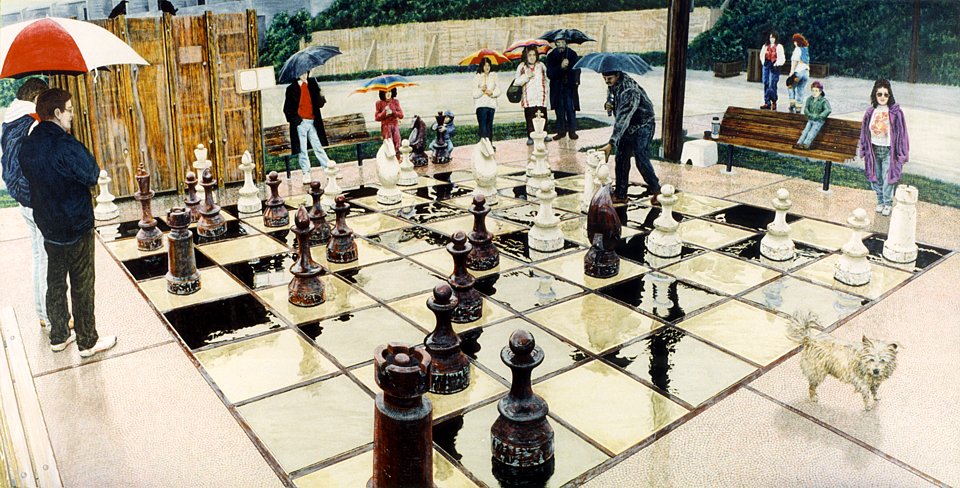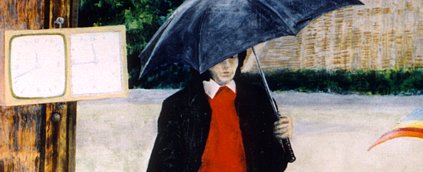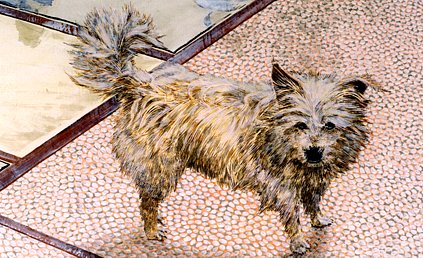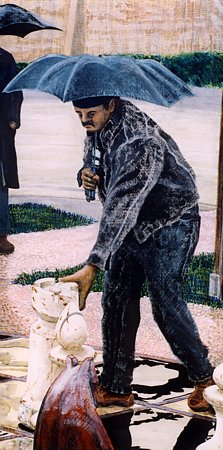|
|

|
|
SATURDAY IN MORRO BAY
© 1997 Keith Halonen oil on panel 96¼×48¼ in / 244×122 cm $ 76,000 US |
|
SATURDAY IN MORRO BAY is one of four paintings featured in Methods and Materials,
Christopher Willard's monthly column, in the May 2002 issue of AMERICAN ARTIST magazine. The other three paintings: 1 | 2 | 3 |

|
« CLICK to contact the artist |





|
CLICK » to order this print |

|
|
YOU ARE IN THE CHESS PAINTINGS GALLERY
CLICK THE SHORTCUT ICONS ABOVE TO VIEW MORE PAINTINGS |
|
Morro Bay is a small coastal town 240 miles south of San Francisco and 30 miles south of San Simeon, site of the famous Hearst Castle. Each Saturday at noon members of the local chess club congregate in Embarcadero Park just a short distance from the Pacific Ocean. They open the cabinet next to the 16 × 16 foot (4.9 × 4.9 meters) board and bring out the giant pieces.
The pieces are solid redwood. The king weighs 35 pounds (16 kilos) and even the minor pieces are a wrestle. As soon as a few pieces are set up an audience begins to form. In any coffeehouse a chess game tends to draw observers, but when the board is the size of a room the viewer appeal escalates accordingly. Giant boards are quite common in Europe. Even small villages may have such a board in the town square. Living chess with human beings serving as pieces is sometimes played for festivals and celebrations. Since 1954 Marostica, Italy, has conducted a biennial reenactment of a living chess game played in 1454 for the hand of a lady. Giant boards like the one in Morro Bay are irresistable to children. Perhaps the oversize pieces make small children feel even smaller, like mouse-size cartoon characters in a chess Wonderland. |
 
|

|
|
|
Detail from
SATURDAY IN MORRO BAY
|
|
A chess clock is really two clocks in one housing. A typical chess clock is operated by both players, who press the button over the nearest clock face after completing a move. This stops the player's clock and sets the opponent's clock ticking.
It is impractical to expect the Morro Bay players to dash back and forth to the clock. To earn a turn on the giant board, a volunteer operates the clock for the players during the current game. This "third party" approach to minding the clock is a method of ensuring that play on the board is not monopolized by any two players. The Morro Bay clock is actually two common wall clocks mounted in a wooden box and wired to a single battery with a toggle switch. Each clock is set for thirty minutes, the collective time allowed each player to achieve checkmate. No game can therefore last longer than one hour. If no checkmate occurs by the time 30 minutes has expired on one of the clock faces, the player whose time control has elapsed forfeits the game "on time." Although time controls vary in different tournaments, the basic idea is the same and even World Champions can lose by time forfeit. |
———————— GALLERIES ————————









|